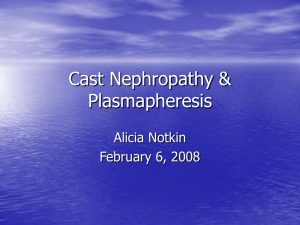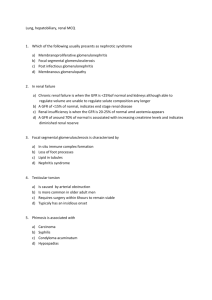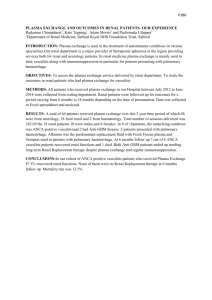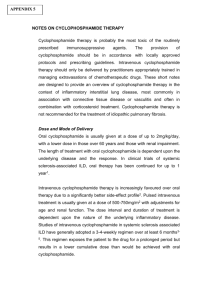Immunomodulating Therapy Cover Letter: AAV & Anti-GBM Disease
advertisement
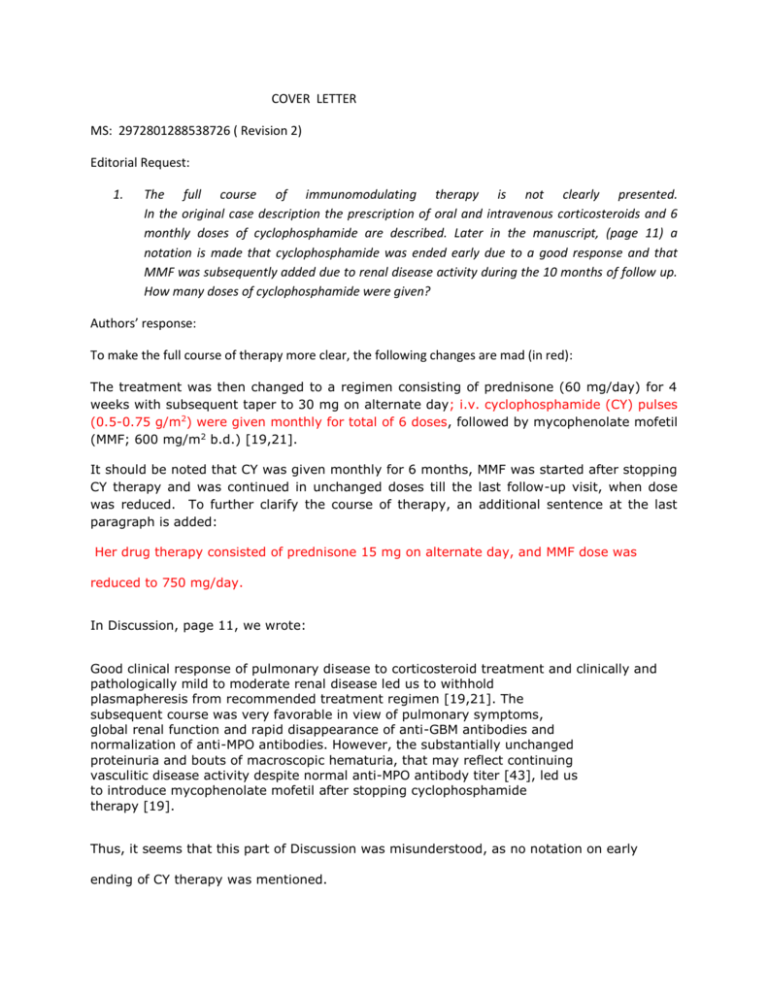
COVER LETTER MS: 2972801288538726 ( Revision 2) Editorial Request: 1. The full course of immunomodulating therapy is not clearly presented. In the original case description the prescription of oral and intravenous corticosteroids and 6 monthly doses of cyclophosphamide are described. Later in the manuscript, (page 11) a notation is made that cyclophosphamide was ended early due to a good response and that MMF was subsequently added due to renal disease activity during the 10 months of follow up. How many doses of cyclophosphamide were given? Authors’ response: To make the full course of therapy more clear, the following changes are mad (in red): The treatment was then changed to a regimen consisting of prednisone (60 mg/day) for 4 weeks with subsequent taper to 30 mg on alternate day; i.v. cyclophosphamide (CY) pulses (0.5-0.75 g/m2) were given monthly for total of 6 doses, followed by mycophenolate mofetil (MMF; 600 mg/m2 b.d.) [19,21]. It should be noted that CY was given monthly for 6 months, MMF was started after stopping CY therapy and was continued in unchanged doses till the last follow-up visit, when dose was reduced. To further clarify the course of therapy, an additional sentence at the last paragraph is added: Her drug therapy consisted of prednisone 15 mg on alternate day, and MMF dose was reduced to 750 mg/day. In Discussion, page 11, we wrote: Good clinical response of pulmonary disease to corticosteroid treatment and clinically and pathologically mild to moderate renal disease led us to withhold plasmapheresis from recommended treatment regimen [19,21]. The subsequent course was very favorable in view of pulmonary symptoms, global renal function and rapid disappearance of anti-GBM antibodies and normalization of anti-MPO antibodies. However, the substantially unchanged proteinuria and bouts of macroscopic hematuria, that may reflect continuing vasculitic disease activity despite normal anti-MPO antibody titer [43], led us to introduce mycophenolate mofetil after stopping cyclophosphamide therapy [19]. Thus, it seems that this part of Discussion was misunderstood, as no notation on early ending of CY therapy was mentioned. 2. Editorial Request: The manuscript describes (discussion) that the pulmonary response to corticosteroids was good but does not suggest that any of the pulmonary stability was related to cyclophosphamide. With the described therapy, one must assume that both the corticosteroids and cyclophosphamide might have be related to survival. Authors’ reponse: This remark is acknowledged and the following sentence was added on page 12: One must assume that both the stability of pulmonary remission and lately achieved complete remission were related to an early intensive corticosteroid and CY therapy, followed by MMF, as an adjunct to the above regimen. 3. Editorial Request: Second paragraph from the end (discussion), treatment does not provide or integrate the nonplasmapharesis treatment option as described in this manuscript. Consider discussing, the traditional approach inclusive of plasmapharesis, the alternative approach implemented in this case due to very early symptom improvement, and a cautionary note suggesting that based on the published case reports including this one, the reported deaths serve as a reminder of the serious nature of the disease in children and that we do not have robust indicators to assist with optimal personalized therapy. Authors’ reponse: Non-plasmapheresis treatment option was almost impossible to find, therefore, it seemed us prudent to consider present case as the exceptional one that, of course, could not serve as a basis for considering non-plasmapheresis option in these cases. In this way, the editorial comment was accepted as very useful in the new part of the Discussion, given below: In both AAV and anti-GBM disease the addition of plasmapheresis to initial immunosuppressive therapy is indicated in patients with severe renal dysfunction or with DAH (19,20,38,39).The recommendation for plasmapheresis in double positive patients is based on the rationale for the treatment of anti-GBM disease (38,39).The observation of worse outcome in patients with double positivity compared to those with either AAV or anti-GBM disease alone (11) may add further support to this strategy. However, it is unknown whether patients with milder alveolar hemorrhage require plasmapheresis (38). According to these criteria, plasmapheresis was indicated in our patient. However, quick favorable response to intensive immunomodulating therapy as well as the absence of severe renal dysfunction, led us to withhold plasmapheresis from the standard treatment approach. In a few anti-GBM disease patients having DAH and normal renal function, good outcome was seen without adding plasmapheresis to immunosuppression (44). However, we could not find a similar case among AAV patients or double positive patients reported to date. The unfavorable outcome in children with double positivity and DAH, having either low or high percentage of glomeruli with crescents (6,14,18), strongly remind of the serious nature of the disease for which we do not still have robust indicator to assist with optimal personalized therapy. This is in keeping with the opinion, expressed in Abstract and in Conclusion, that plasmapheresis should be held as mandatory treatment option in these patients. Please note that all changes in this revision of the MS are in RED.

